See also:
Mitsui Bank, Nihonbashi, c. 1905
Tatsuno Kingo, a student of Josiah Conder, was the architect of the Bank of Japan and the first native Japanese to be commissioned with a project of that type. (Tatsuno would later be commissioned to design Tokyo Central Station and the National Sumo Hall at Kuramae, and he developed an influential style that would become the standard throughout Japan’s overseas empire, particularly in Manchukuo.) The Bank of Japan, as completed, was also a three-story building, inspired by Classical Revical architecture and was constructed of brick faced with stone and was the first use of reinforced structural steel for architecture in Japan. The exterior is also marked by owl keystones, which pay homage to the Ainu guardian deity, Kamui Chikap Kamui.
The gold mint used by the feudal Tokugawa government was set up in the early 1600s at the foot of one of Edo’s oldest bridges, Tokiwabashi, connecting the mint to Edo Castle. On the site now stands the Nippon Ginko, the Bank of Japan, established by the Meiji government in 1882. The design of its headquarters remains one of the few Western-style architectural relics of the Meiji Era (1868-1912) still in existence to have survived both the 1923 earthquake and World War II firebombings. The bank facilitated the consolidation of all three feudal-era coin currencies under one roof (gold, silver and copper), along with managing the financial fortunes of Japan as the Meiji government pressed to modernize the country in the years following the imperial return to national primacy.
Of the great trading houses founded during the Edo period, with exclusive licenses to conduct currency exchanges, none, perhaps, became more closely aligned with the Tokugawa regime and its successor, the Meiji government, than the Mitsui Bank. It was in 1683 that the Tokugawa Shogunate granted Mitsui Takatoshi permission to act as a money changer, after which he then developed a new system of inter-city loans. Following the Restoration, Mitsui incorporated itself in 1876 as Japan’s first private bank. (It was Takatoshi’s father who opened the shop in Matsusaka called Echigoya, known today as Mitsukoshi.) By 1890, deposits in the Mitsui Bank accounted for 40 per cent of the total deposits of all regular banks. And, ass one of the principal and favored trading houses, the Mitsui Bank enjoyed certain political patronage, including the transacting of large government deposits and tax collection services rendered to the Ministry of Finance.
- Bank of Japan, street view, c. 1910.
- Bank of Japan (left) & Mitsui Bank (center), Nihonbashi, c. 1910.
- Looking across Ikkoku-bashi, toward the Bank of Japan (white structure, center) and Tokiwa-bashi (left), c. 1915.
- Mitsukoshi department store (with towers) and the u-shaped Mitsui Bank, c. 1920.
- The Mitsui Bank, destroyed in the 1923 Great Kanto earthquake.
- The new Mitsui Bank (foreground), and Mitsukoshi department store (part of the Mitsui zaibatsu), c. 1935.
Mitsui Bank, in 1873, constructed a three-story building designed by Kisuke Shimizu, a master carpenter with traditional skills who also designed the First National Bank and the Tsukiji Seiyoken hotel.
This first Mitsui building was of an unusual design, mixing Japanese and Western architectural styles by placing traditional castle-like roofs atop colonial-style building. The Mitsui Exchange Bank was topped with a huge dolphin cast in bronze. According to folklore, the green dolphin would protect the building from fire. By the end of the 19th century, though, the building was considered something of an embarrassment. It was torn down and replaced by a more traditionally Western-style building of red brick and stone.
It was from there the bank was headquartered until planning for an even larger building was begun in the early 1920s, in the classic Corinthian style and would be completed in 1929. Mitsui’s main business in the early Meiji period were drapery, finance and trade, the first two being the businesses it inherited from the Tokugawa Era. It entered into mining because it acquired a mine. Mitsui soon become the biggest business in pre-war Japan, and one of the largest zaibatsu [conglomerate].



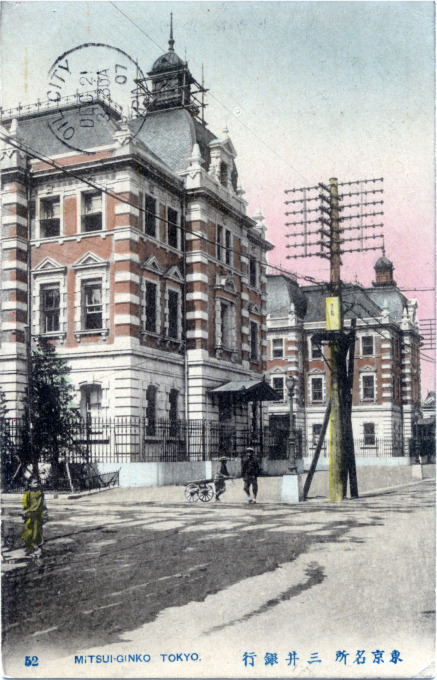
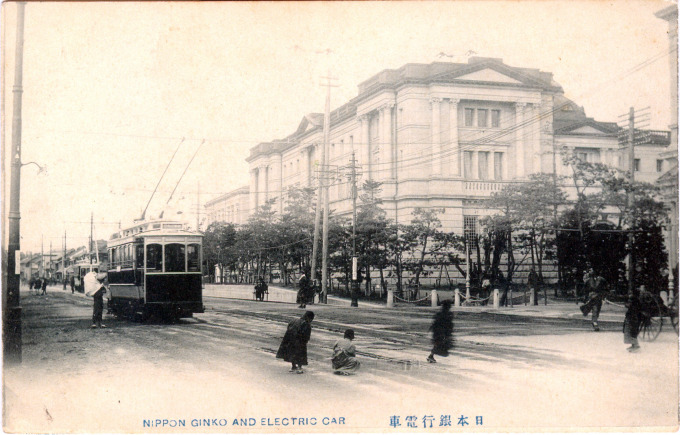
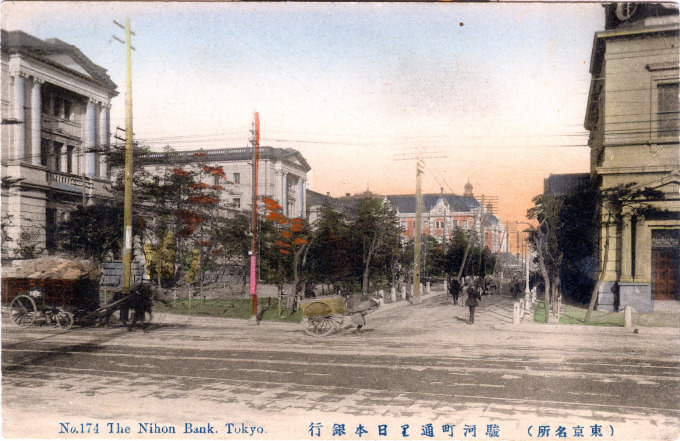
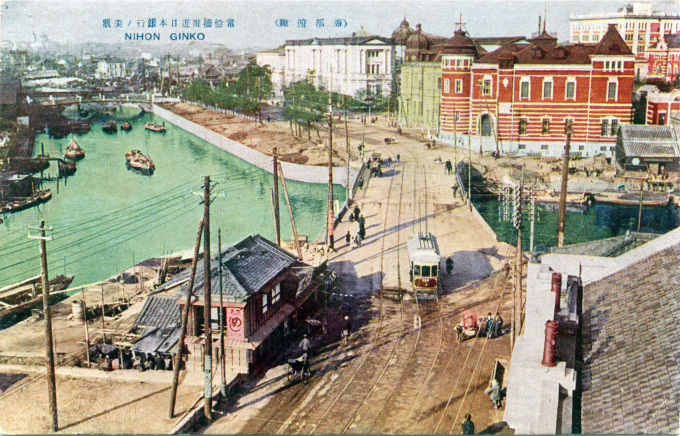
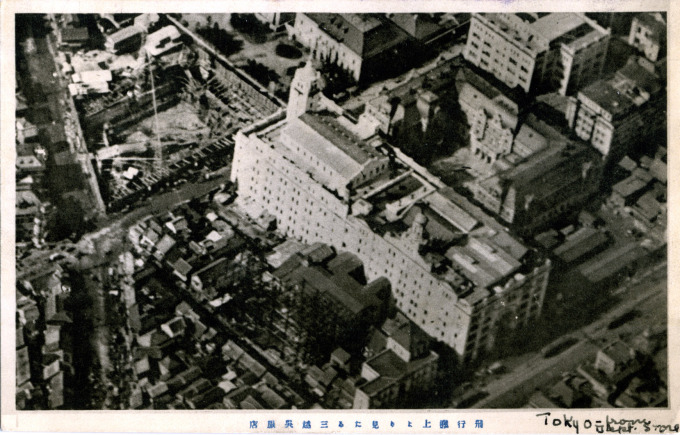
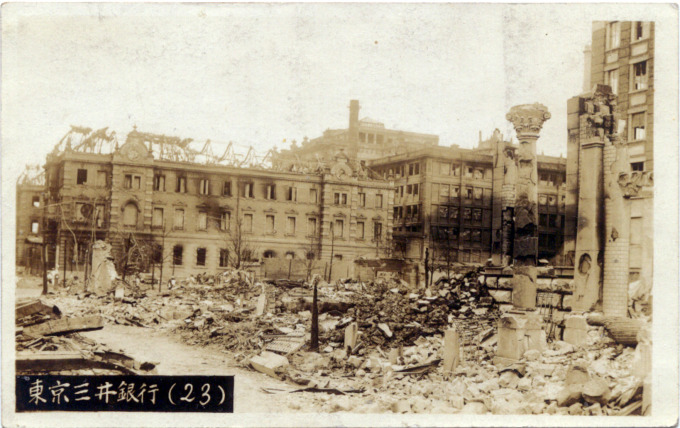
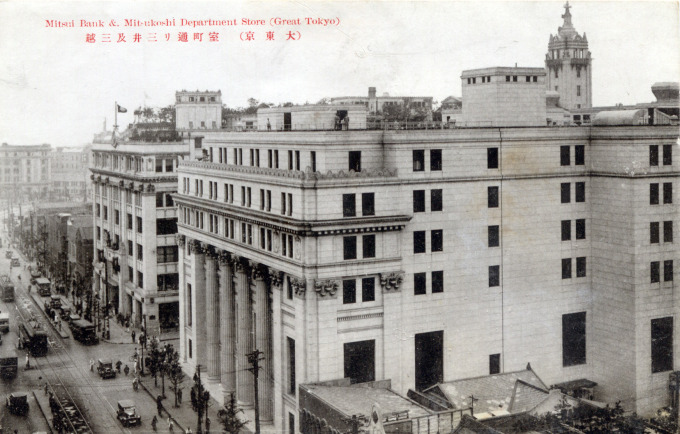
Pingback: Josiah Conder: Department of the Navy, Kasumigaseki, c. 1910 | Old Tokyo
Pingback: Imperial Hemp Building, Nihonbashi, c. 1920. | Old Tokyo
Pingback: Dai-ichi Sogo Building, Kyobashi, c. 1920. | Old Tokyo
Pingback: Kyoto Hakubutsukan (Imperial Museum), c. 1920. | Old Tokyo
Pingback: Kokugikan (National Sport Hall). | Old Tokyo
Pingback: Mitsui Bank, Nihonbashi, c. 1905. | Old TokyoOld Tokyo